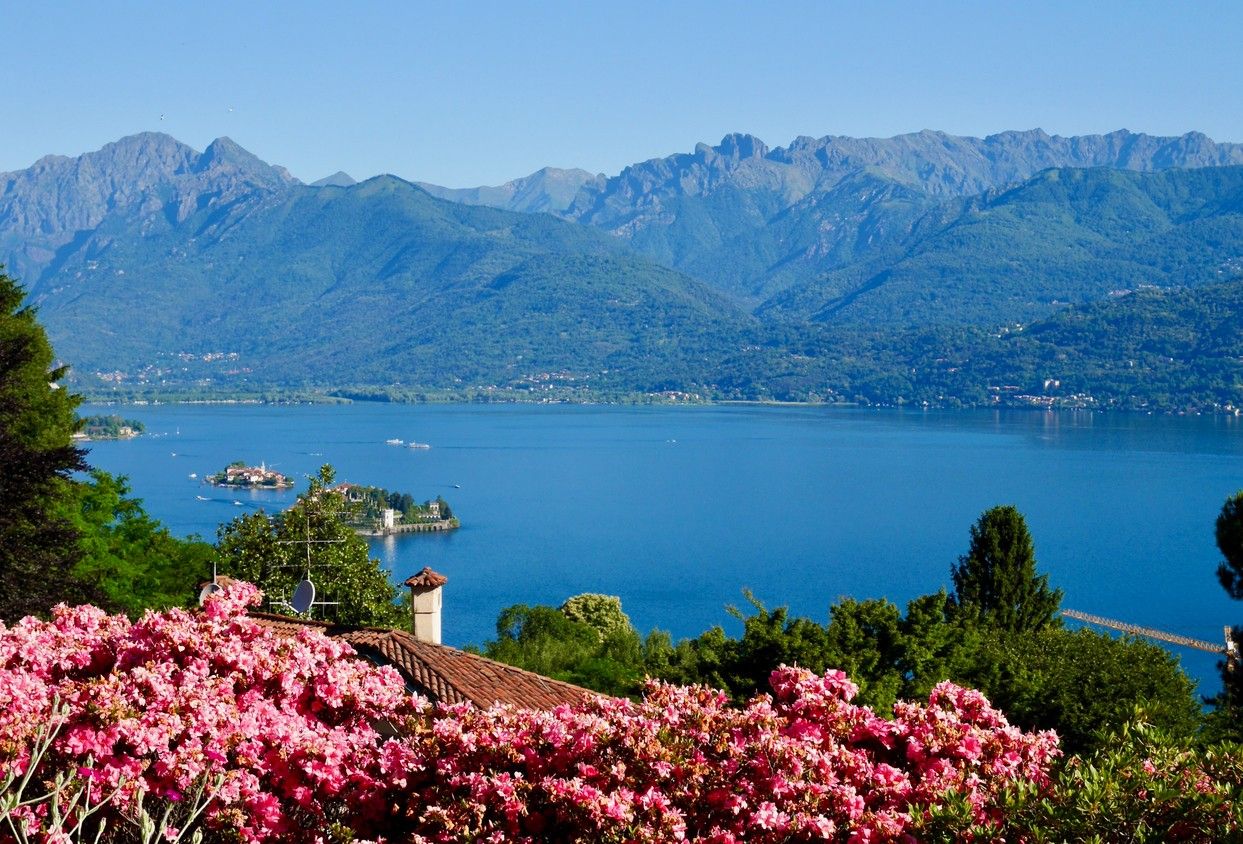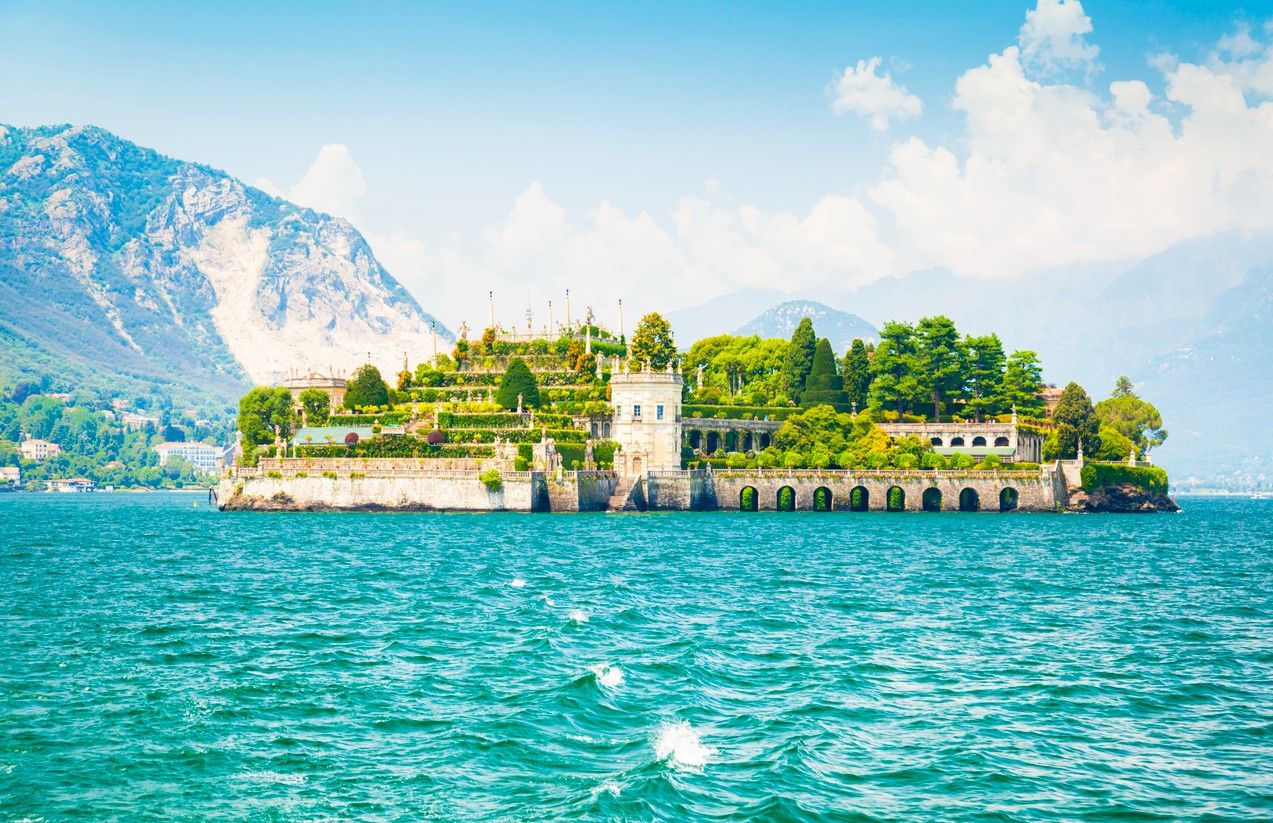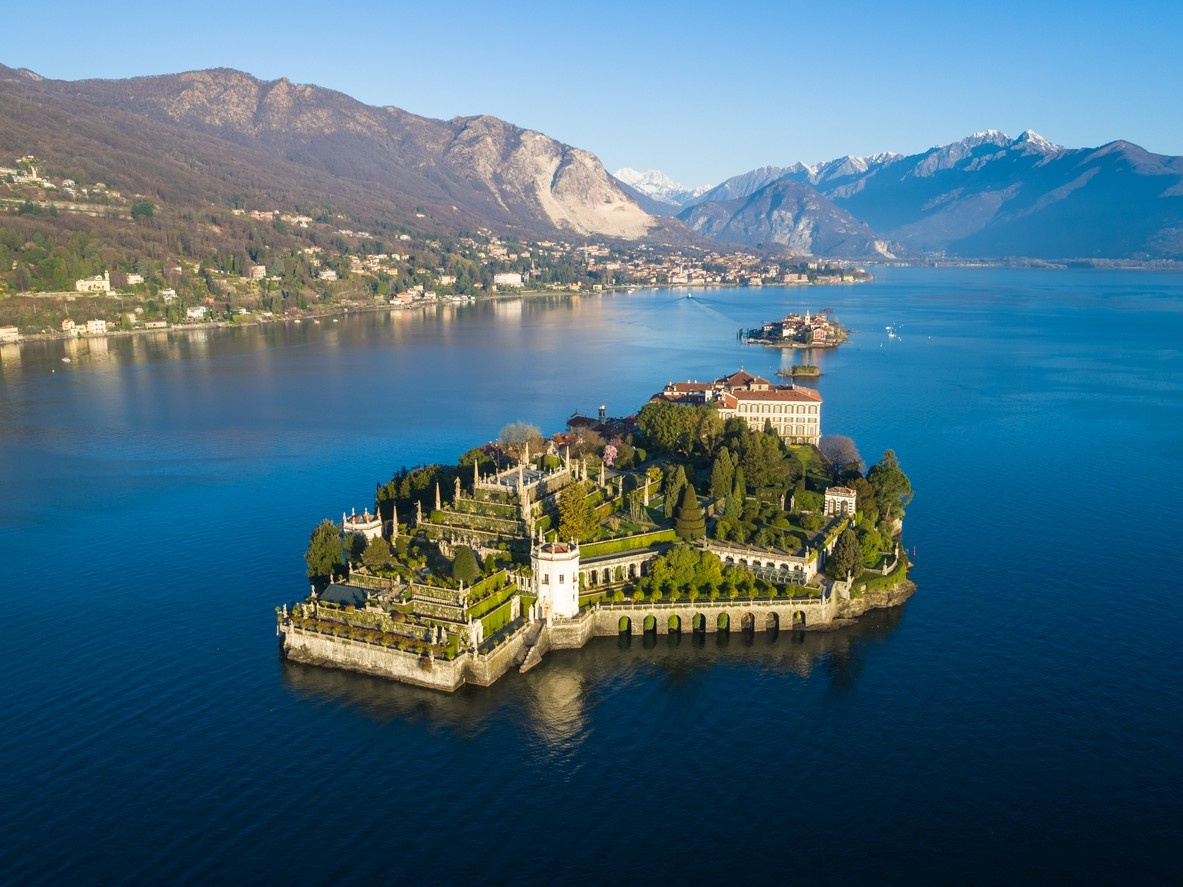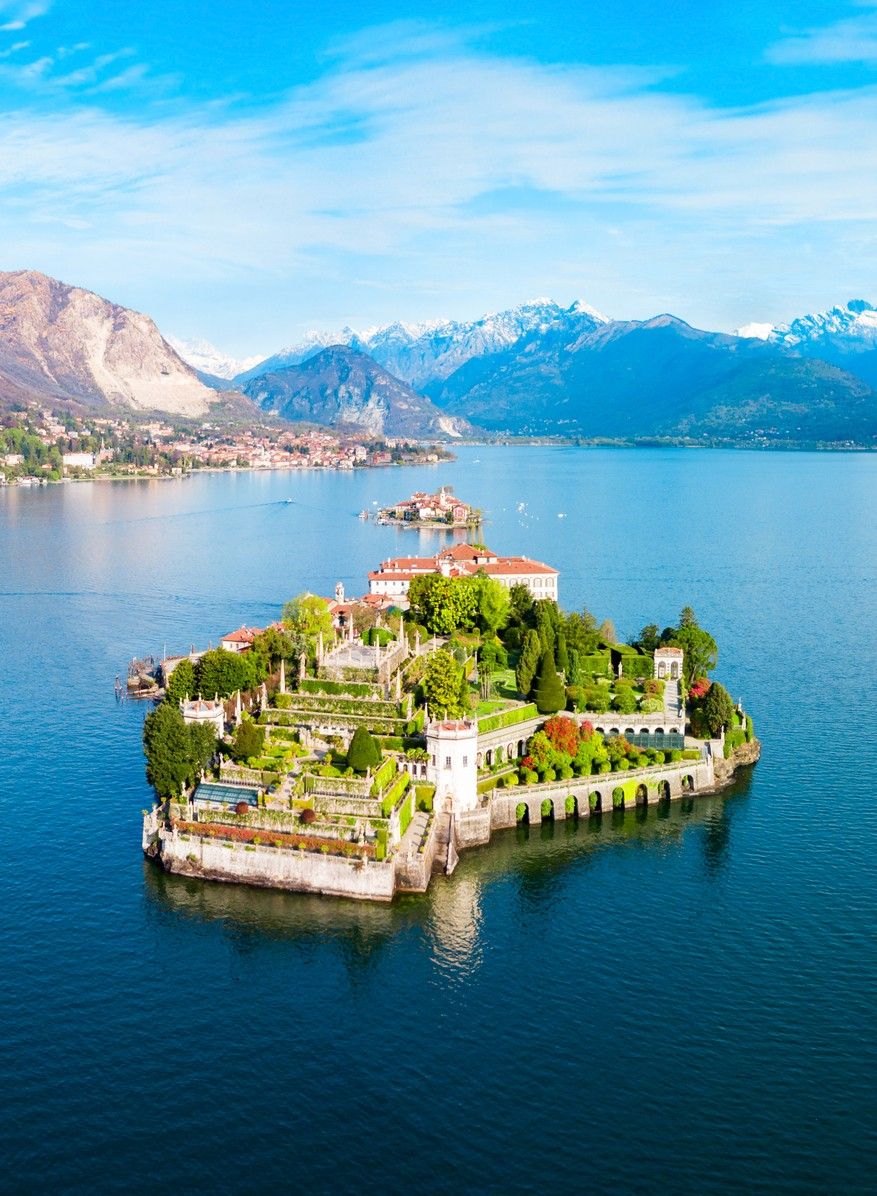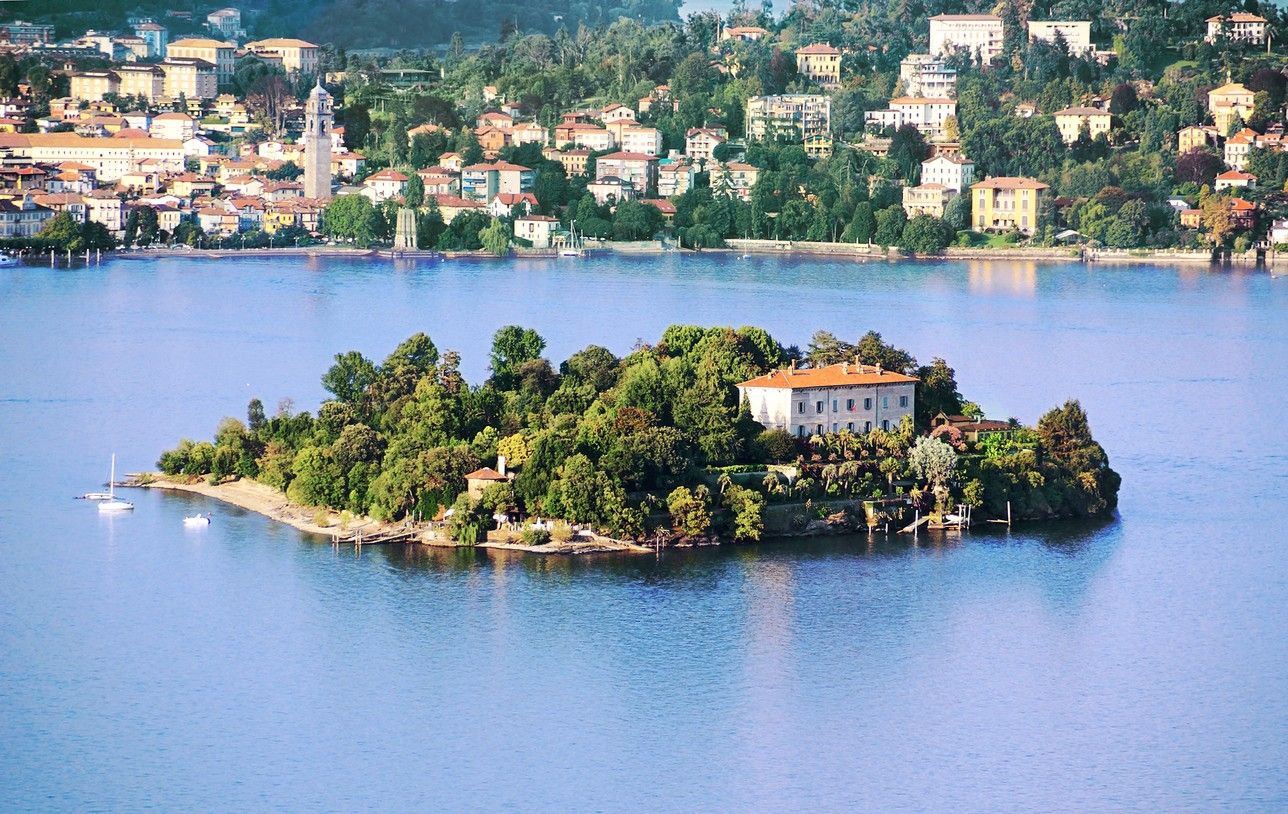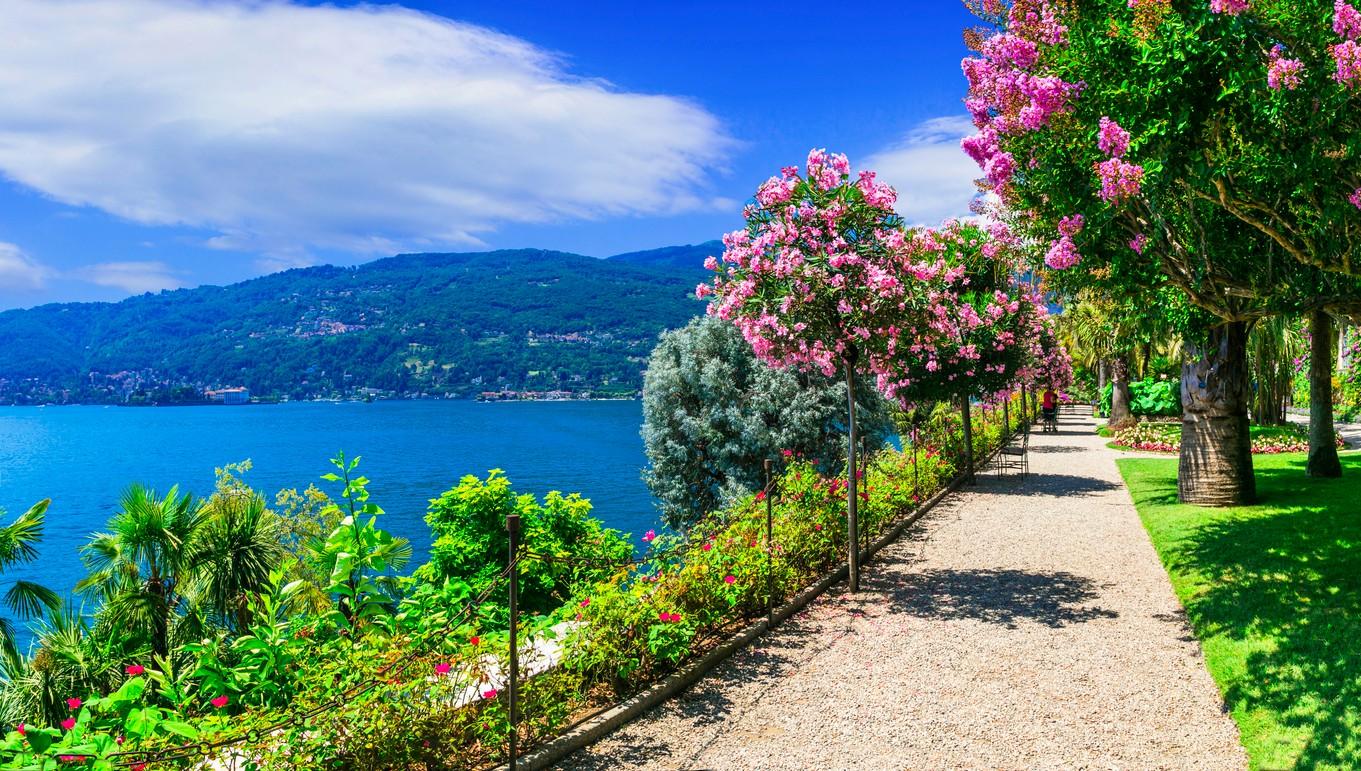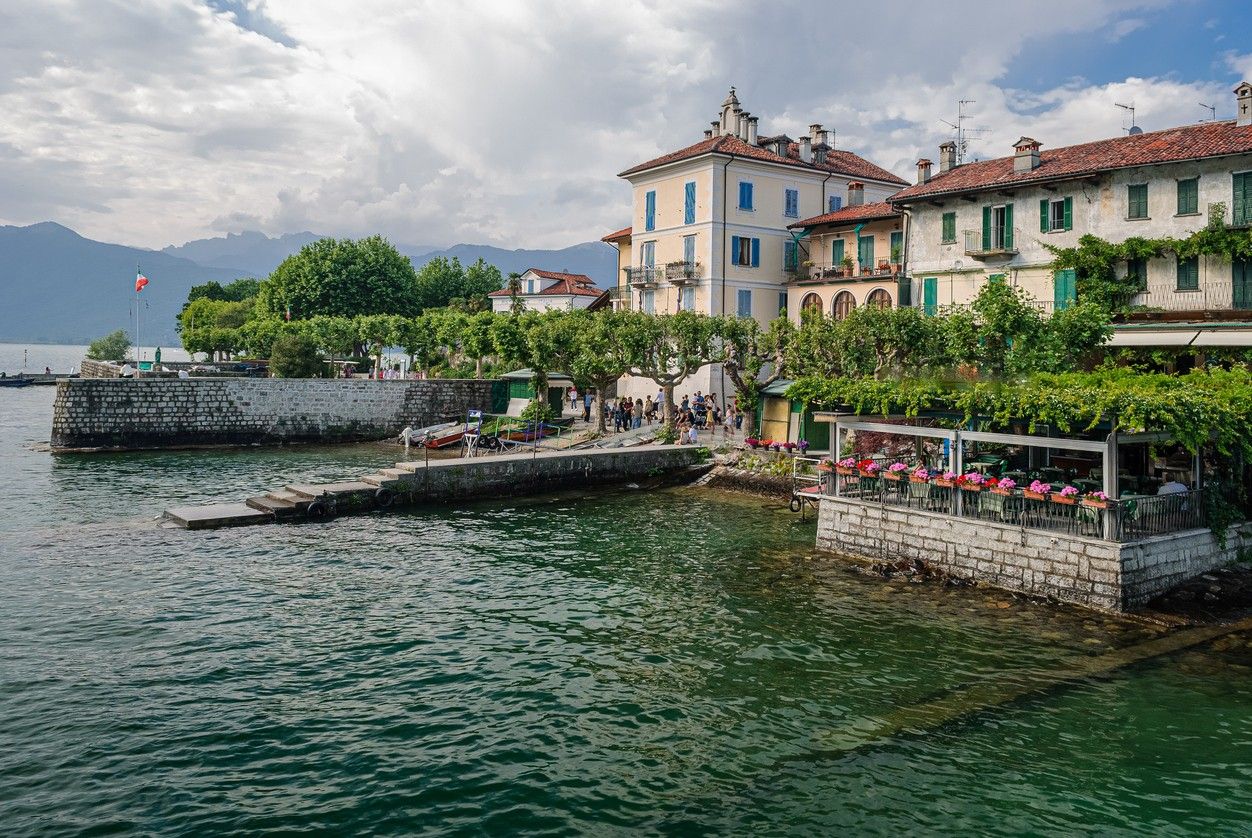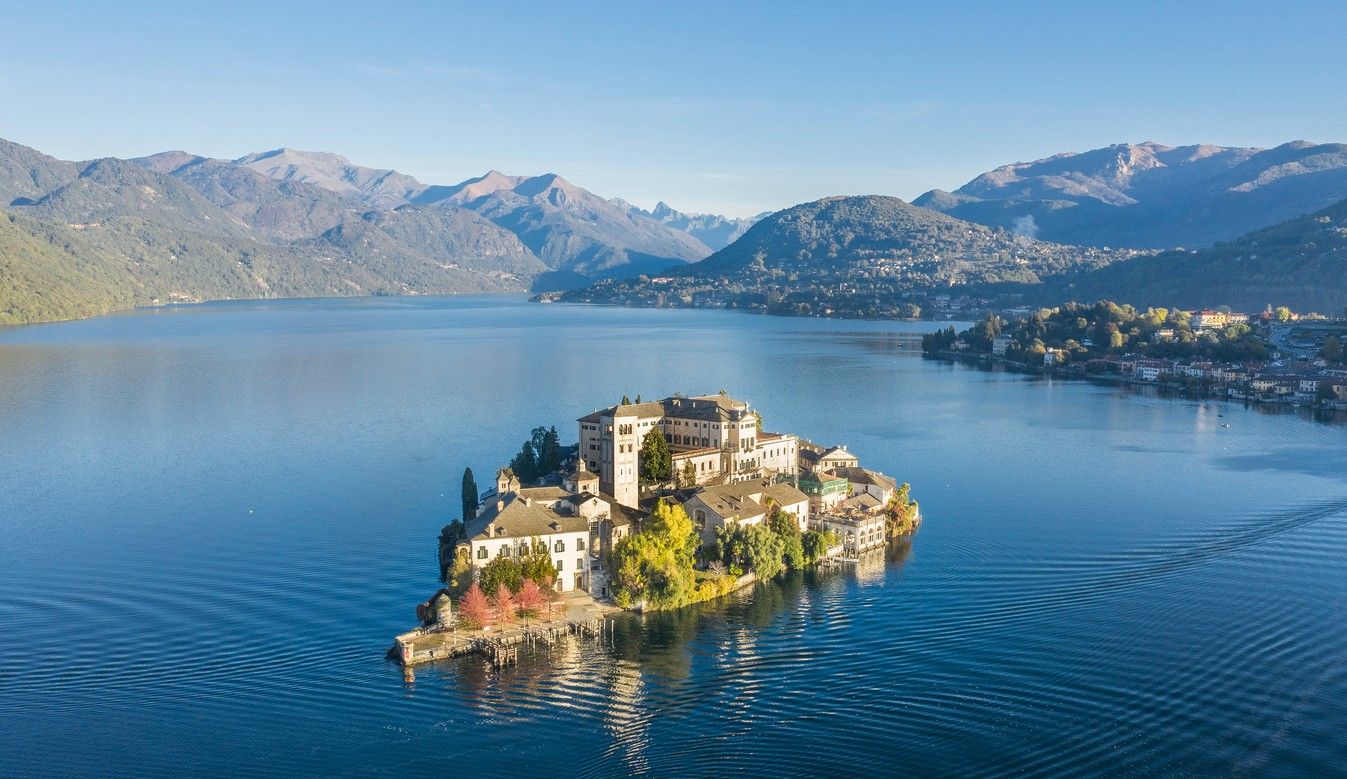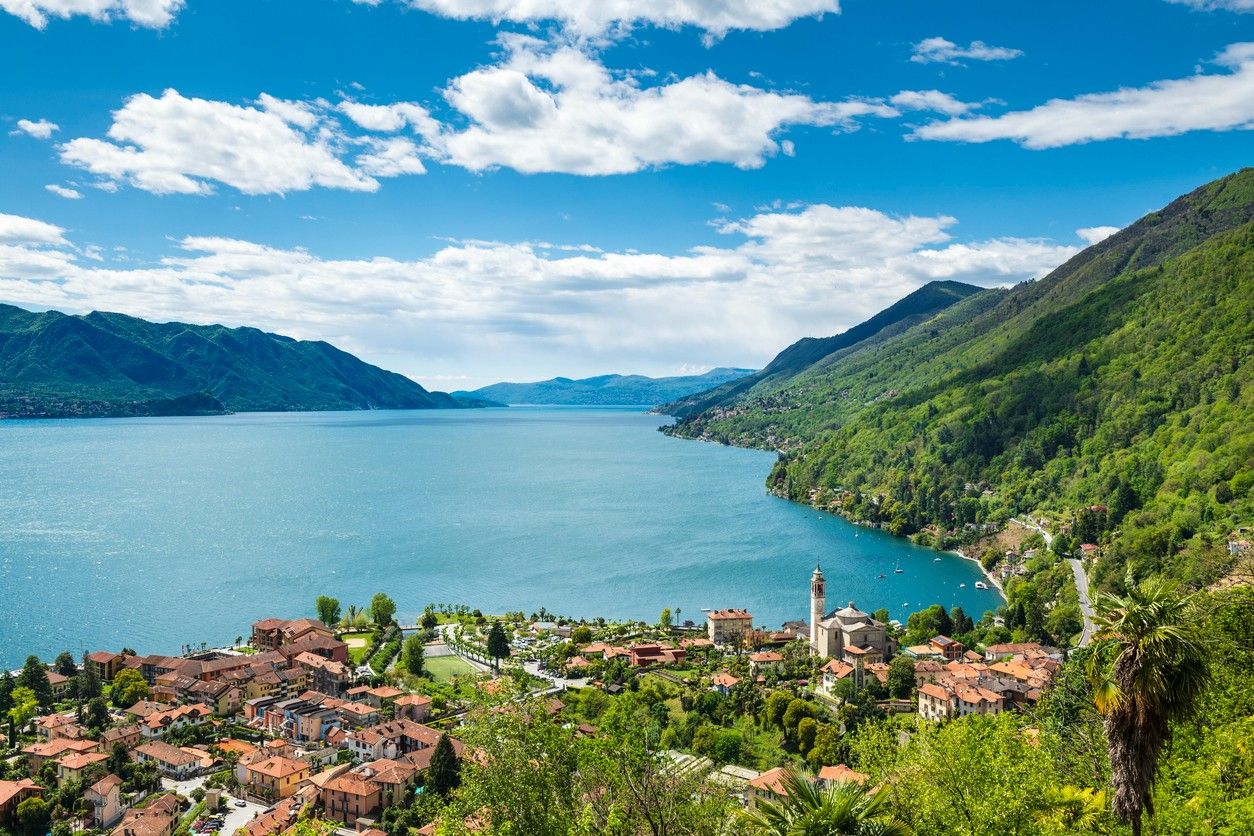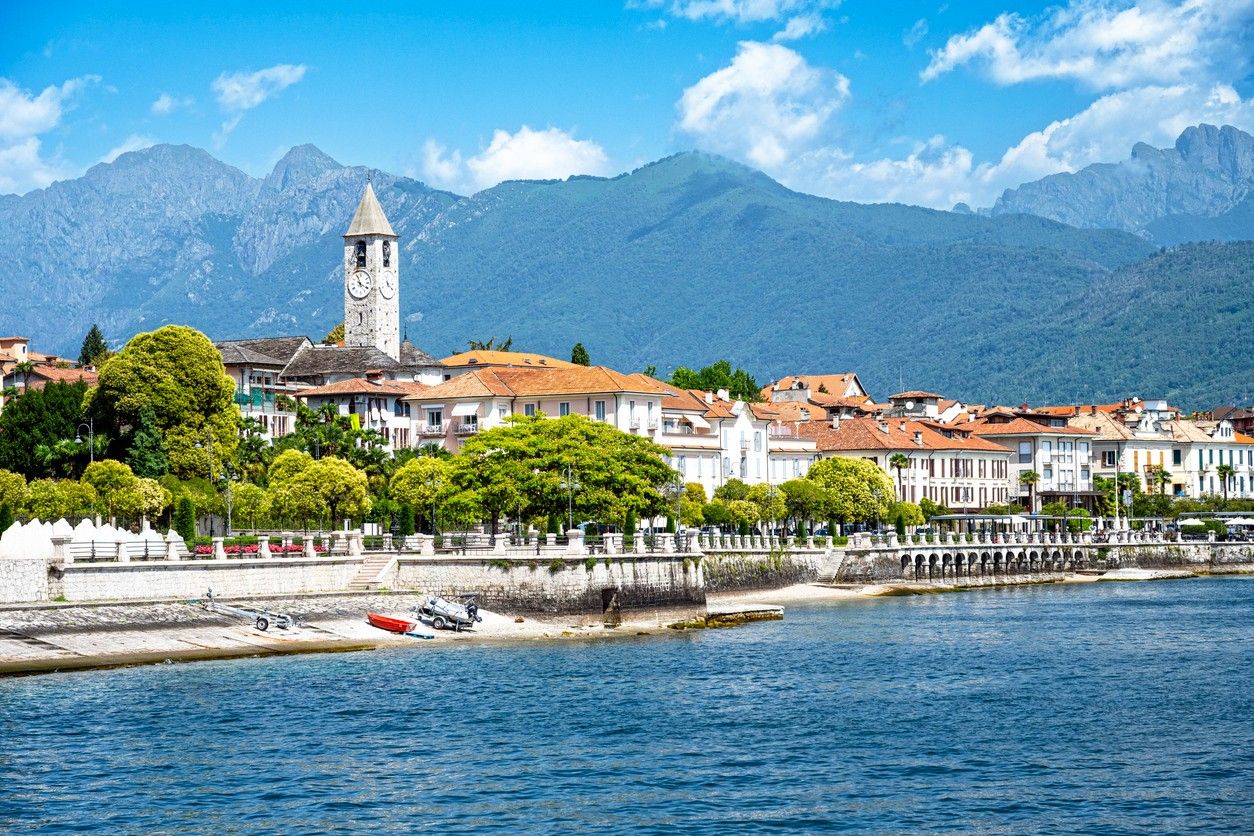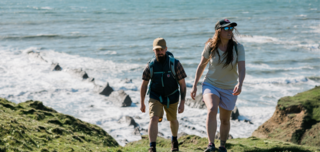Lake Maggiore is a stunning natural wonder located in the northern part of Italy, straddling the regions of Piedmont and Lombardy, as well as extending into the Swiss canton of Ticino. As the second-largest lake in Italy, Lake Maggiore has long been a popular destination for tourists seeking breathtaking scenery, outdoor activities, and charming lakeside towns. The lake's crystal-clear waters, set against the backdrop of the majestic Alps, create a picturesque landscape that captivates visitors worldwide. Lake Maggiore was formed during the last ice age when glaciers carved out the deep basin that now holds the lake's waters. The lake is fed by several rivers, including the Ticino, Toce, and Tresa, and is drained by the Ticino River at its southern end. The lake's depth varies, with the deepest point reaching approximately 370 meters (1,214 feet) near the town of Ghiffa. The climate around Lake Maggiore is generally mild, with warm summers and cool winters. This favourable weather allows for a long tourist season, typically extending from April to October. The lake's microclimate also supports a diverse array of flora, including Mediterranean vegetation such as olive trees, citrus fruits, and exotic flowers.
The Borromean Islands: Jewels of Lake Maggiore
The Borromean Islands are a group of four small islands located in Lake Maggiore, off the towns of Baveno and Stresa in northwestern Italy. Named after the Borromeo family who have owned them since the 12th century, these picturesque islands are known for their stunning palaces, gardens, and charming fishing villages. The most famous of the islands is Isola Bella, with its 17th-century Palazzo Borromeo and terraced gardens; Isola Madre, the largest island featuring a palazzo and lush botanical gardens; and Isola dei Pescatori, a quaint fishing village with narrow streets and excellent seafood restaurants.
Isola Bella
Isola Bella, the most famous of the Borromean Islands, is a remarkable example of the power, wealth, and artistic vision of the Borromeo family. The island's transformation from a barren rock to a magnificent baroque palace and garden complex is a testament to the family's dedication and the skill of the architects, artists, and landscapers who worked on the project over the centuries. The Palazzo Borromeo, the island's centrepiece, is a masterpiece of baroque architecture. The construction of the palace began in 1632 under the direction of Carlo III Borromeo and continued under his sons, Cardinal Giberto III and Vitaliano VI. The design of the palace is attributed to several renowned architects, including Francesco Maria Richini, Angelo Crivelli, and Carlo Fontana, who each contributed to the building's unique style and character.
The interior of the Palazzo Borromeo is a treasure trove of art and opulence, with each room showcasing the family's wealth and taste. The Salone Nuovo, or New Hall, is adorned with an impressive collection of tapestries and furniture, while the Galleria del Generale Berthier features a series of six large paintings depicting the battles of Napoleon's general, Louis-Alexandre Berthier. The Throne Room, with its stunning Murano glass chandelier and intricate stucco work, served as the reception room for visiting dignitaries and is a testament to the family's power and influence. One of the most unique and fascinating features of the Palazzo Borromeo is the series of six grottoes located on the lower level. These grottoes, designed to resemble natural caves, are decorated with a variety of materials, including shells, pebbles, stucco, and even stalactites. The creation of these grottoes required great skill and creativity, as the designers sought to replicate the look and feel of natural cave formations. The grottoes served not only as a source of entertainment for the Borromeo family and their guests but also as a practical solution to the summer heat problem, providing a cool retreat from the sun.
The gardens of Isola Bella are a masterpiece of Italian baroque landscaping, designed by renowned architects such as Giovanni Angelo Crivelli and Angelo Provasi. The gardens are laid out on ten terraces, rising from the lake to the top of the island, and feature a stunning array of statues, fountains, and exotic plants. The creation of these gardens was a massive undertaking, requiring the transportation of soil, plants, and building materials to the island, as well as the construction of complex irrigation systems to ensure the survival of the vegetation. The lowest terrace of the gardens, known as the Teatro Massimo, features a series of statues depicting mythological figures and animals, as well as a large basin with a central fountain. These statues, created by skilled sculptors, are not only beautiful works of art but also serve as a reminder of the classical themes and motifs that were popular during the Baroque period.
The upper terraces of the gardens are home to a variety of rare and exotic plants, including citrus trees, magnolias, and camellias, which thrive in the island's mild microclimate. Culturing these plants required great skill and knowledge, as the gardeners had to carefully select species that could adapt to the island's unique conditions. One of the most impressive features of the gardens is the Giardino all'Italiana, or Italian Garden, located on the fifth terrace. This garden, designed in the classic Italian style, features geometric flower beds, manicured hedges, and a central fountain. The creation of this garden required great precision and attention to detail, as the gardeners sought to create a harmonious and balanced design that would showcase the beauty of the plants and the skill of the landscapers. The gardens also feature a stunning pavilion, known as the Casina delle Cappelle, which offers panoramic views of the lake and the surrounding mountains. This pavilion, with its ornate design and intricate details, is a testament to the wealth and taste of the Borromeo family, who spared no expense in the creation of this magnificent structure.
Visitors to Isola Bella can explore the palace and gardens at their own pace or join guided tours that provide insight into the island's history and the Borromeo family's legacy. The palace's interior is filled with works of art, furniture, and decorative objects that provide a glimpse into the opulent lifestyle of the aristocracy during the Baroque period. The gardens, with their stunning terraces, fountains, and statues, offer a peaceful retreat from the hustle and bustle of modern life and a chance to appreciate the beauty and harmony of nature. Isola Bella also features a small shopping area where visitors can purchase souvenirs, local crafts, and speciality food items. These shops offer a chance to take home a piece of the island's history and culture, whether in the form of a handcrafted object or a locally produced delicacy.
Isola Madre
Isola Madre, the largest of the Borromean Islands, is a lush and tranquil oasis that offers a unique and captivating experience for visitors. While Isola Bella is known for its grand baroque palace and intricate gardens, Isola Madre is celebrated for its extensive botanical gardens and laid-back atmosphere, providing a perfect complement to its more opulent neighbour. The island's history dates back to the 9th century when it was home to a small chapel dedicated to San Vittore. In the 16th century, the Borromeo family acquired the island and began construction on the Palazzo Borromeo, which would serve as a summer residence for the family. The palace, built in a simple and elegant style, reflects the island's more relaxed character and provides a contrast to the grandeur of the Palazzo Borromeo on Isola Bella. Today, the Palazzo Borromeo on Isola Madre serves as a museum, showcasing the family's collection of art, furniture, and decorative objects. One of the palace's most notable features is the Salone delle Quattro Stagioni, or Hall of the Four Seasons, which is adorned with a series of intricate tapestries depicting the changing of the seasons. These tapestries, created by skilled artisans, are not only beautiful works of art but also serve as a reminder of the importance of the natural world and the passage of time. The palace also houses a unique collection of marionettes and puppets, a testament to the Borromeo family's love of theatre and the performing arts. These intricate and beautifully crafted figures provide a glimpse into the cultural interests and pastimes of the aristocracy during the 16th and 17th centuries.
However, the true star of Isola Madre is its extensive botanical gardens, which cover most of the island's 7.8 hectares (19 acres). The gardens, first established in the late 18th century by Lancillotto Borromeo, are home to an incredible variety of rare and exotic plants from around the world, many of which are not typically found in the region. The creation and maintenance of these gardens required great skill, knowledge, and resources, as the plants had to be carefully selected, transported, and cultivated to ensure their survival in the island's unique microclimate. The result is a stunning collection of flora that showcases the diversity and beauty of the natural world. The gardens are divided into several distinct areas, each with its unique character and charm.
The Giardino dei Limoni, or Lemon Garden, is home to a collection of citrus trees, including lemons, oranges, and grapefruits, which thrive in the island's mild climate. The cultivation of these trees required specialized knowledge and techniques, as the gardeners had to ensure that the plants received the proper amount of sunlight, water, and nutrients to produce healthy fruit.
The Giardino delle Camelie, or Camellia Garden, features over 150 varieties of camellias, which bloom in a stunning array of colours from late winter to early spring. The cultivation of camellias requires great skill and patience, as the plants are sensitive to changes in temperature and humidity and require specific soil conditions to thrive.
The Giardino Esotico, or Exotic Garden, is perhaps the most impressive area of the botanical gardens, home to a wide variety of tropical and subtropical plants, including palm trees, banana plants, and orchids. The creation of this garden required not only the transportation of exotic species from around the world but also the construction of specialised greenhouses and irrigation systems to ensure the plant's survival.
Visitors to Isola Madre can explore the palace and gardens at their own pace, following the winding paths and discovering the many hidden corners and scenic viewpoints. The island also features a small chapel, a quaint fishing village, and a café offering refreshments and light meals, providing visitors with a chance to relax and enjoy the tranquil surroundings.
The island's laid-back atmosphere and natural beauty make it a popular destination for those seeking a peaceful retreat from the hustle and bustle of modern life. Whether strolling through the lush gardens, admiring the exotic birds, or simply enjoying the stunning views of the lake and surrounding mountains, visitors to Isola Madre are sure to be enchanted by the island's unique charm and beauty.
Isola dei Pescatori
Isola dei Pescatori, the smallest and most charming of the Borromean Islands, offers a unique glimpse into the traditional way of life on Lake Maggiore. Unlike the other islands, which are known for their grand palaces and lush gardens, Isola dei Pescatori is a working fishing village with a rich history and a vibrant local community that has maintained its authentic character for centuries. The island's origins date back to the 10th century when it was inhabited by a small community of fishermen who relied on the lake's abundant fish stocks for their livelihood. Over time, the island grew and developed, with the construction of houses, churches, and other buildings that reflected the needs and traditions of the fishing community.
Isola dei Pescatori is home to around 50 permanent residents, many of whom are descendants of the original fishing families and continue to practice the same traditions and crafts as their ancestors. The heart of the island is the Piazza Vittorio Emanuele III, a small square that serves as the social and commercial centre of the community. The square is surrounded by restaurants, shops, and the Church of San Vittore, which dates back to the 11th century and is dedicated to the island's patron saint. The church, with its beautiful frescoed interior and bell tower, is a testament to the island's long religious history and the importance of faith in the lives of its residents. Isola dei Pescatori is renowned for its excellent seafood restaurants, which serve fresh, locally caught fish and traditional dishes that reflect the island's culinary heritage. Visitors can sample specialities such as risotto al pesce persico, a creamy rice dish made with perch from the lake, or pasta con agoni, a pasta dish featuring a type of local freshwater sardine. These dishes prepared using traditional recipes and techniques, offer a taste of the island's unique cuisine and the skill and expertise of its chefs.
Isola dei Pescatori is also known for its traditional lace-making craft, which has been practised on the island for centuries. The intricate, handmade lace, created using techniques passed down from generation to generation, is a testament to the skill and creativity of the island's artisans. Visitors can watch local craftspeople at work and purchase beautiful lace products, such as tablecloths, doilies, and clothing accessories, as souvenirs of their visit. Despite its small size, Isola dei Pescatori has played a significant role in the history of the region, serving as a strategic location for trade and commerce. In 1935, the island hosted the signing of the Stresa Front, an agreement between Italy, France, and the United Kingdom aimed at maintaining the status quo in Europe and preventing German aggression. While the agreement ultimately failed to prevent the outbreak of World War II, it remains a notable event in the island's history and a testament to its importance in the political and diplomatic affairs of the time.
One of the best times to visit Isola dei Pescatori is during the annual Festa dei Pescatori, or Fishermen's Festival, which takes place on the second weekend of August. During this celebration, the island comes alive with music, dancing, and fireworks, as the local community honours its fishing heritage and the patron saint, San Vittore. Visitors can join in the festivities, sampling traditional foods and drinks, watching colourful processions and performances, and experiencing the warm hospitality of the islanders. Throughout the year, Isola dei Pescatori maintains its laid-back, welcoming atmosphere, offering visitors a chance to escape the stresses of modern life and immerse themselves in a simpler, more authentic way of living. Whether exploring the island's narrow streets, chatting with locals, or enjoying a delicious seafood meal by the water's edge, visitors to Isola dei Pescatori are sure to be charmed by the island's unique character and the warmth and friendliness of its people.
Outdoor Activities & Adventures around Lake Maggiore
Lake Maggiore offers a wide range of outdoor activities for visitors to enjoy, catering to various interests and fitness levels. Popular activities include hiking on numerous trails in the surrounding mountains and forests, such as the scenic routes on Mottarone mountain; water sports like swimming, boating, and fishing on the lake's crystal-clear waters; cycling along the lake's perimeter road or exploring quiet country roads in the hillsides; and golfing at several excellent courses in the area, such as the prestigious Golf Club des Iles Borromées in Stresa.
Hiking
Lake Maggiore offers a wide range of outdoor activities for visitors to enjoy, catering to various interests and fitness levels. One of the most popular activities is hiking, with numerous trails winding through the surrounding mountains and forests.
Here are the best trails and routes available around Lake Maggiore:
Alpe San Michele
Collina di San Quirico
Sentiero Fornaci
Antica Mulattiera
Da Laveno
Val Veddasca
Monteviasco
Cannobio
Fondotoce Nature Reserve
Mottarone
Water Sports
For those who prefer water-based activities, Lake Maggiore provides ample opportunities for swimming, boating, and water sports. Many towns along the lakeshore have public beaches and swimming areas, while boat rentals and guided tours are readily available for those who wish to explore the lake's hidden coves and islands.
Stand-Up Paddle (SUP): Explore the stunning landscapes of Lake Maggiore while paddling on a SUP. Rentals are available, with prices starting from €15 per person for a 10-minute session. The Maggia Delta is an ideal spot for SUP, offering breathtaking views.
Water Skiing: Experience the thrill of gliding across the waters of Lake Maggiore on water skis. 10-minute sessions start from €40 per person. Cannobio offers perfect conditions for water skiing.
Wakeboarding: Combine the excitement of water skiing and snowboarding with wakeboarding on Lake Maggiore. 10-minute sessions start from €40 per person. Cannobio provides opportunities for beginners and experienced riders.
Wakesurf: Surf the waves created by a boat on Lake Maggiore. 10-minute sessions start from €40 per person.
Sailing: Enjoy the gentle breeze and stunning mountain views while sailing on Lake Maggiore. Sailing courses and boat rentals are available in Cannobio.
Kitesurfing and Windsurfing: Harness the power of the wind and glide across the lake on a kiteboard or windsurf. Cannobio offers ideal conditions for these thrilling sports.
Diving: Discover the fascinating underwater world of Lake Maggiore. Diving schools in Cannobio offer courses for beginners and guided dives for experienced divers.
Kayaking and Canoeing: Paddle along the picturesque shoreline and explore hidden bays and beaches. Kayaks and canoes can be rented to enjoy the tranquillity and beauty of Lake Maggiore. The Bolle di Magadino nature reserve is a stunning spot for canoeing.
Wakesurfing: Surf the continuous wave created by a boat's wake on Lake Maggiore. This sport is similar to surfing but without the need for ocean waves.
Wakefoiling: A combination of wakeboarding and hydrofoiling, this exciting sport allows you to glide above the water on a foil attached to a wakeboard.
E-Foil: Experience the future of watersports with an electrically-powered surfboard equipped with a hydrofoil. Glide elegantly over the waves and enjoy fantastic views of Lake Maggiore. Training courses and rentals are available near Cannobio.
Boat Tours: Explore the stunning Borromean Islands, including Isola dei Pescatori, on boat tours departing from Stresa.
Cycling
Cycling enthusiasts will delight in the scenic bike routes that surround Lake Maggiore. Lake Maggiore offers a diverse range of cycling routes for enthusiasts of all levels, from leisurely lakeside rides to challenging mountain climbs:
Tour of the 4 lakes - A 50 km route that takes you around Lake Maggiore and three other nearby lakes, offering stunning views and varied terrain.
Tre Valli Varesine route - A challenging 72 km ride through the three valleys of Varese, known for its steep climbs and technical descents.
Lake Maggiore Bike Experience - A 90 km route that circumnavigates the entire lake, passing through picturesque towns and villages on both the Italian and Swiss sides.
The 7 Termini - An epic 105 km ride that takes you through seven mountain passes around Lake Maggiore, testing your endurance and climbing skills.
Monte Bre climb from Locarno - A scenic climb from the Swiss town of Locarno to the summit of Monte Bre, offering panoramic views of the lake and surrounding mountains.
Ascona - Brissago - Ronco - A picturesque route along the western shore of Lake Maggiore, passing through the charming towns of Ascona, Brissago, and Ronco.
Centovalli and Val Cannobina from Ascona - A challenging ride through the remote valleys of Centovalli and Val Cannobina, starting from the Swiss town of Ascona.
Valmaggia and Lake Naret climb from Locarno - A stunning climb from Locarno to Lake Naret, passing through the beautiful Valmaggia valley.
Alpe di Neggia climb from Vira - A demanding climb from the village of Vira to the Alpe di Neggia, a scenic alpine pasture overlooking Lake Maggiore.
Val Verzasca climbs from Gordola - A spectacular ride through the Val Verzasca, known for its crystal-clear waters and ancient stone bridges, starting from the town of Gordola.
Camping around the Lake
For those seeking a more immersive experience, camping is a popular option around Lake Maggiore. Several well-equipped campsites can be found along the lakeshore, offering stunning views and easy access to the water. Here are the top 10 campsites in the area:
Camping Lago Maggiore - Located in Tenero, Switzerland, this top-rated campsite is recommended for swimming and is suitable for families with young children.
Camping Lido - Situated in Cannobio, Italy, this top-rated campsite in Piedmont is recommended for swimming and is suitable for guests with dogs.
Camping Miralago - Located in Fondotoce, Italy, this top-rated campsite in Piedmont is recommended for swimming and is suitable for families with young children.
Camping Tamaro - Situated in Cugnasco, Switzerland, this top-rated campsite in Ticino is recommended for hiking and is suitable for guests with dogs.
Camping Orchidea - Located in Feriolo di Baveno, Italy, this top-rated campsite in Piedmont is recommended for swimming and is suitable for senior citizens.
Camping Isolino - Situated in Fondotoce, Italy, this popular campsite offers a variety of amenities and activities for guests, with a 4.3 rating on Tripadvisor based on over 2,200 reviews.
Camping Solcio - Located in Lesa, Italy, this popular campsite offers convenient access to the lake and nearby attractions, ranked #1 among speciality lodging options in Lesa on Tripadvisor.
Conca D'Oro Camping & Lodge - Located in Verbania, Italy, this campsite offers a range of accommodation options and is ideal for families, with a 4.5 rating on Tripadvisor based on over 900 reviews.
Camping Piccolo Paradiso - Situated in Vira, Switzerland, this campsite is recommended for cycling, suitable for guests with tents, and is top-rated for cleanliness.
Camping Parisi - Located in Baveno, Italy, this campsite offers a prime location near the lake and is suitable for families with children.
Exploring the Towns and Villages of Lake Maggiore
The shoreline of Lake Maggiore is dotted with charming towns and villages, each with its unique character, history, and attractions. Some notable destinations include Stresa, an elegant town known for its luxurious hotels, beautiful villas, and proximity to the Borromean Islands; Verbania, featuring the stunning Villa Taranto botanical gardens and a picturesque old quarter; Luino, famous for its weekly open-air market, one of the largest in Europe; Cannobio, with its beautiful lakefront promenade and historic town centre; and Baveno, known for its pink granite quarries and stunning views of the Borromean Islands.
Stresa
Stresa, a charming town located on the western shore of Lake Maggiore in the Piedmont region of Italy, has long been a favourite destination for tourists seeking a blend of natural beauty, elegance, and cultural richness. The town's history as a popular resort dates back to the early 19th century when it began attracting European aristocrats and intellectuals drawn to its mild climate, stunning scenery, and luxurious villas. One of Stresa's most iconic attractions is the Borromean Islands, a group of three small islands located just off the shore. The most famous of these is Isola Bella, home to the stunning Palazzo Borromeo and its elaborate Italianate gardens. The palace, built in the 17th century, features a series of ornate rooms filled with art, furniture, and decorative objects, while the gardens are laid out on ten terraces, adorned with statues, fountains, and exotic plants. Back on the mainland, Stresa boasts a beautiful lakefront promenade lined with grand hotels, restaurants, and cafes. The promenade offers stunning views of the lake and the surrounding mountains, making it a perfect spot for a stroll or a relaxing meal. The town itself is home to several notable buildings and landmarks, including the Villa Pallavicino, a 19th-century neo-classical villa surrounded by a vast park featuring exotic animals and beautiful gardens. The park is open to the public and offers a delightful setting for a picnic or a quiet walk.
Stresa is also known for its cultural events and festivals, such as the Stresa Festival, an annual summer music festival featuring classical concerts performed in various locations around the town, including the stunning lakeside gardens of Villa Giulia. For those interested in exploring the surrounding area, Stresa serves as an excellent base. The Mottarone Cable Car, located just outside the town, offers a scenic ride up to the summit of Mount Mottarone, providing breathtaking panoramic views of Lake Maggiore and the Alps. The mountain is also a popular destination for hiking and skiing, depending on the season. Stresa's combination of natural beauty, historic charm, and cultural richness makes it an ideal destination for visitors seeking a quintessential Italian lake experience. Whether exploring the town's elegant villas and gardens, savouring local cuisine at a lakeside restaurant, or venturing into the surrounding mountains, Stresa offers a wealth of opportunities for relaxation, discovery, and inspiration.
Verbania
Verbania, a vibrant city situated on the western shore of Lake Maggiore in the Piedmont region of Italy, is a popular destination for tourists seeking a blend of natural beauty, cultural attractions, and outdoor activities. The city, formed in 1939 by the merger of the towns of Intra and Pallanza, is the largest on the lake and serves as an important commercial and administrative centre. One of Verbania's main attractions is the stunning Villa Taranto, a botanical garden located in the Pallanza district. The garden, established in 1931 by Scottish captain Neil McEacharn, features over 20,000 plant species from around the world, including rare and exotic varieties. The garden's highlights include a Dahlia maze, a water garden, and a collection of lotus flowers. The villa itself, a beautiful example of Italian rationalist architecture, now serves as a museum showcasing the history of the garden and its creator. Another notable landmark in Verbania is the Palazzo Viani Dugnani, a 17th-century palace located in the heart of the city. The palace, now home to the Verbania City Museum, features a collection of artworks, archaeological artefacts, and historical exhibits related to the city and the surrounding region.
Verbania is also known for its picturesque lakefront promenade, which stretches along the shore of Lake Maggiore, offering stunning views of the water and the surrounding mountains. The promenade is lined with restaurants, cafes, and gelaterias, making it a perfect spot for a stroll or a refreshing gelato. The city is surrounded by beautiful hiking trails, including the Sentiero Azzurro (Blue Trail), which winds along the lakeshore, offering stunning views of the water and the nearby islands. The trail also passes through the charming fishing village of Suna, known for its narrow streets and colourful houses.
Another popular activity in Verbania is cycling, with several scenic bike routes in and around the city. The most notable of these is the Ciclovia del Lago Maggiore, a 65-kilometer (40-mile) bike path that runs along the western shore of the lake, connecting Verbania with other lakeside towns and villages. Verbania is also a great base for exploring the nearby Valgrande National Park, Italy's largest wilderness area. The park offers a variety of hiking trails, ranging from easy walks to challenging mountain treks, as well as opportunities for wildlife spotting and birdwatching.
Luino
Luino, a charming town located on the eastern shore of Lake Maggiore in the Lombardy region of Italy, is known for its picturesque setting, rich history, and vibrant weekly market. The town, situated about halfway between the cities of Varese and Locarno, has long been a popular destination for tourists seeking a more laid-back and authentic Italian lake experience.
One of Luino's main attractions is its famous weekly market, held every Wednesday in the town's central square and surrounding streets. The market, one of the largest in the region, features hundreds of stalls selling a wide variety of goods, including fresh produce, clothing, household items, and local crafts. The market attracts visitors from all over the region and is a great place to experience the local culture and sample regional specialities. Luino's historic town centre is another draw for visitors, with its narrow, winding streets, colourful buildings, and charming piazzas. The town's main square, Piazza Garibaldi, is lined with cafes and restaurants, making it a perfect spot for people-watching and enjoying a cappuccino or an aperitivo. The town is also home to several notable churches, including the Church of San Pietro in Campagna, a beautiful Romanesque church dating back to the 12th century, and the Church of San Giuseppe, known for its stunning frescoes and baroque interior.
Luino's lakefront promenade is another popular spot for visitors, offering stunning views of Lake Maggiore and the surrounding mountains. The promenade is lined with benches and shaded by trees, making it a perfect place for a relaxing stroll or a picnic lunch. The town is surrounded by beautiful hiking trails, including the Sentiero del Viandante (Wayfarer's Path), a scenic trail that runs along the eastern shore of Lake Maggiore, offering stunning views of the water and the nearby mountains. The trail passes through several charming villages and hamlets, including the picturesque fishing village of Colmegna. Another popular activity in Luino is cycling, with several bike routes in and around the town. The most notable of these is the Ciclovia del Lago Maggiore, a bike path that runs along the shore of the lake, connecting Luino with other lakeside towns and villages. Luino is also a great base for exploring the nearby Parco Regionale Campo dei Fiori, a regional park known for its beautiful forests, meadows, and hiking trails. The park is home to a variety of flora and fauna, including rare orchids and bird species, making it a popular destination for nature lovers and birdwatchers.
Related Articles

Let us know you agree to cookies
We use marketing, analytical and functional cookies as well as similar technologies to give you the best experience. Third parties, including social media platforms, often place tracking cookies on our site to show you personalised adverts outside of our website.
We store your cookie preferences for two years and you can edit your preferences via ‘manage cookies’ or through the cookie policy at the bottom of every page. For more information, please see our cookie policy.
